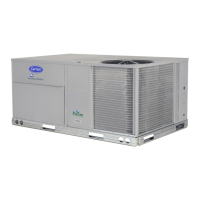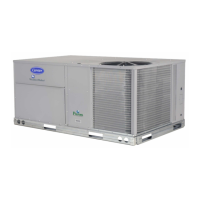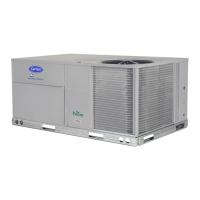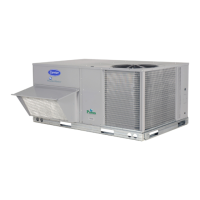
Do you have a question about the Carrier WeatherMaker 50A3 020-060 and is the answer not in the manual?
| Brand | Carrier |
|---|---|
| Model | WeatherMaker 50A3 020-060 |
| Category | Air Conditioner |
| Language | English |
Essential safety precautions and warnings for installing and servicing air-conditioning equipment.
Provides an overview of the manual's scope, conventions, and basic information about the unit.
Explains the functionality and flexibility of the ComfortLink control system for managing unit operations.
Details the procedures for unit setup, including wiring, accessories, controls configuration, and gas heat checks.
Provides step-by-step guides for configuring various unit types and control options.
Outlines procedures for testing cooling and heating operations using the unit's service test feature.
Explains how to integrate external devices like thermostats, IAQ sensors, and VFDs with the unit.
Details the operation of control modes, HVAC modes, and various configuration parameters.
Explains the system, HVAC, and control modes, including their hierarchical decision-making process.
Describes machine-dependent configurations that define unit type, fan mode, and sensor inputs.
Provides details on setting up cooling modes, compressor staging, and temperature-dependent control logic.
Explains the different heating control types and configurations, including staged gas and electric heat.
Details how ComfortLink controls manage VAV systems using VFDs and pressure sensors.
Explains how to monitor fan status, including failure detection and configuration options.
Information on the operation and configuration of the dirty filter switch accessory.
Describes economizer control functions, including free cooling and configuration options.
Explains the control strategies for managing building pressure using power exhaust and VFDs.
Details the four smoke control modes: Pressurization, Evacuation, Smoke Purge, and Fire Shutdown.
Describes IAQ functions, including Demand Controlled Ventilation (DCV) and economizer adjustments.
Explains how the unit controls dehumidification and reheat based on humidity and temperature sensors.
Details the logic for delaying unit start-up to pre-condition the space based on temperature.
Information on configuring the unit for CCN communication and network settings.
Configuration of set points for system alerts related to temperature, pressure, and IAQ.
Calibration procedures for various sensors to match actual measured readings.
Configuration of normally open/closed status for switches and inputs.
Options for configuring the local display settings, including units and language.
Configuration of the remote switch input for controlling occupancy or start/stop functions.
Information on the function and control of the hot gas bypass system for capacity staging.
Allows occupants to adjust space temperature set points via a slider on the T56 sensor.
Procedure for programming local time schedules for unit operation, including holidays and daylight saving.
Guidance for diagnosing and resolving operational problems, including unit stoppages and alarms.
Identifies potential causes for complete unit shutdown and provides diagnostic steps.
Detailed service analysis tables and diagrams for troubleshooting cooling and gas heating issues.
Lists and explains various alarm and alert codes, their probable causes, and recommended actions.
Details the key electronic control system components and their functions.
Describes the main components like MBB, ECB1, ECB2, SCB, CEM, and IGC boards.
Provides instructions for performing maintenance tasks, including cleaning and component replacement.
Guidance on safely accessing unit components for servicing, including door and latch procedures.
Instructions for inspecting and removing main burners, including spark gap adjustment.
Procedures for cleaning coil surfaces to maintain unit performance and extend coil life.
Steps for adjusting evaporator fan speed and alignment, including pulley and belt tension.
Information on determining and adjusting refrigerant charge based on unit specifications and charts.
Procedure for adjusting the natural gas valve to ensure proper fuel supply.












